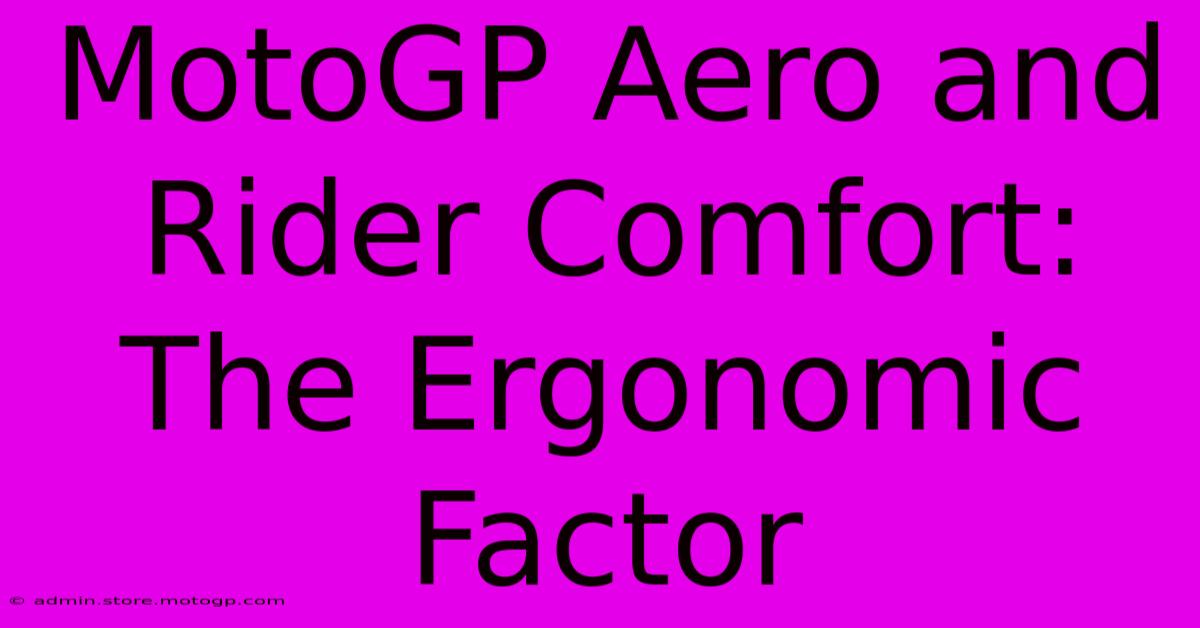MotoGP Aero And Rider Comfort: The Ergonomic Factor

Table of Contents
MotoGP Aero and Rider Comfort: The Ergonomic Factor
MotoGP racing is a relentless pursuit of speed and performance. Every millisecond shaved off lap times can mean the difference between victory and defeat. While horsepower and tire grip are crucial, a frequently overlooked element contributing to a rider's success is the ergonomic integration of the motorcycle and rider. This involves the sophisticated interplay between aerodynamics and rider comfort. This article delves into the crucial relationship between MotoGP aero and rider comfort, highlighting how seemingly small adjustments can significantly impact performance.
The Aerodynamic Advantage: More Than Just Speed
Aerodynamics in MotoGP isn't just about reducing drag; it's about maximizing downforce. Downforce, the force pressing the bike to the track, is critical for high-speed cornering stability and acceleration. Sophisticated winglets, fairings, and underbody designs all contribute to generating this vital downforce. However, the aerodynamic package isn't solely about the machine; it's intrinsically linked to the rider's position and posture.
Rider Posture and Aerodynamic Efficiency
A rider's posture directly influences the overall aerodynamic performance. Tucking reduces frontal area, minimizing drag and improving top speed. However, maintaining this position for extended periods is physically demanding, requiring significant strength and endurance. Compromise is key. Riders need to find a balance between aerodynamic efficiency and a sustainable riding position that prevents fatigue and discomfort.
The Impact of Aero on Rider Comfort
The aerodynamic components themselves can also impact rider comfort. Winglets, while generating downforce, can create turbulence and buffeting, particularly at higher speeds. This can lead to rider fatigue and reduced control. Similarly, the shape and design of the fairing can affect airflow around the rider, influencing temperature and wind pressure on different body parts. Ergonomic design considerations are therefore crucial in mitigating these negative impacts.
The Ergonomic Equation: Rider Comfort Meets Performance
Rider comfort is not a luxury in MotoGP; it's a necessity for optimal performance. A fatigued or uncomfortable rider is a slower rider. Ergonomics, the science of designing workplaces and equipment to suit the people who use them, plays a vital role in achieving both comfort and speed.
Customized Ergonomics for Peak Performance
Factory MotoGP teams employ highly specialized technicians and physiotherapists to tailor the motorcycle's ergonomics to each rider. This involves precise adjustments to:
- Handlebar position: Affects rider posture and control input.
- Footpeg position: Influences rider weight distribution and leverage.
- Seat shape and padding: Impacts rider comfort and stability.
- Fairing design: Directly affects airflow around the rider.
These seemingly minor adjustments can dramatically influence a rider's ability to maintain optimal control and speed over the course of a race. A perfectly tailored setup maximizes rider comfort and enables them to perform at their peak for the entirety of the race.
The Future of MotoGP Aero and Ergonomics
The ongoing pursuit of aerodynamic and ergonomic optimization in MotoGP is relentless. Computational fluid dynamics (CFD) and wind tunnel testing play increasingly important roles in analyzing and refining designs. Furthermore, advancements in materials science allow for lighter and more adaptable components, contributing to improved performance and rider comfort. We can expect to see even more sophisticated integrations of aerodynamics and ergonomics in future MotoGP machines, leading to further gains in speed and overall performance.
Conclusion: A Symbiotic Relationship
The relationship between MotoGP aero and rider comfort is symbiotic. Aerodynamic advancements must not come at the cost of rider well-being; rather, the two elements should be integrated seamlessly to maximize performance. Through continuous innovation and ergonomic considerations, MotoGP teams are pushing the boundaries of what's possible, achieving breathtaking speeds while ensuring the riders are comfortable enough to handle the extreme demands of the sport. The quest for speed is always at the forefront, but without rider comfort, that speed becomes significantly more challenging to achieve.

Thank you for visiting our website wich cover about MotoGP Aero And Rider Comfort: The Ergonomic Factor. We hope the information provided has been useful to you. Feel free to contact us if you have any questions or need further assistance. See you next time and dont miss to bookmark.
Featured Posts
-
Austin Grand Prix Parking Dont Miss A Minute Of The Action
Feb 17, 2025
-
Sprint Race Results A Spectacle Of Speed And Power
Feb 17, 2025
-
V 4 Yamaha Vs The Competition
Feb 17, 2025
-
Bike Racing On Tv Celebrating Cycling Excellence
Feb 17, 2025
-
Top Speed Moto Gp Bike The Ultimate Racing Machine
Feb 17, 2025
